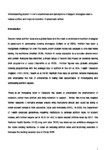Exploring support strategies for improving nursing student retention
| dc.contributor.author | Edge, Danielle | |
| dc.contributor.author | Gladstone, N | |
| dc.date.accessioned | 2022-11-14T13:43:41Z | |
| dc.date.issued | 2022-08-31 | |
| dc.identifier.issn | 0029-6570 | |
| dc.identifier.issn | 2047-9018 | |
| dc.identifier.uri | http://hdl.handle.net/10026.1/19968 | |
| dc.description.abstract |
Nursing student attrition is a significant concern in many countries, including the UK. Higher education institutions (HEIs) are seeking creative ways of improving retention and it is crucial to understand which support strategies encourage students to persist with their studies. This article describes a systematic review of the literature exploring nursing students' experiences and perceptions of support strategies used by HEIs to reduce attrition and improve retention. Having a sense of belonging, a connection with the university, self-confidence, self-efficacy and motivation appeared to make students more likely to stay on their course. Several support strategies appeared to enhance retention, including an automated text messaging system, an Academic, Personal and Professional Learning (APPL) support mechanism, a pastoral care support adviser service and an extracurricular student support group. Developing a holistic and multifaceted approach to retention involves working collaboratively with students to enhance the understanding of their needs. | |
| dc.format.extent | 28-33 | |
| dc.format.medium | Print-Electronic | |
| dc.language | en | |
| dc.language.iso | eng | |
| dc.publisher | RCN Publishing Ltd. | |
| dc.subject | career pathways | |
| dc.subject | education | |
| dc.subject | pre-registration education | |
| dc.subject | professional | |
| dc.subject | recruitment and retention | |
| dc.subject | student recruitment | |
| dc.subject | students | |
| dc.subject | universities | |
| dc.subject | workforce | |
| dc.subject | workplace planning | |
| dc.subject | Education, Nursing, Baccalaureate | |
| dc.subject | Humans | |
| dc.subject | Motivation | |
| dc.subject | Students, Nursing | |
| dc.subject | Universities | |
| dc.title | Exploring support strategies for improving nursing student retention | |
| dc.type | journal-article | |
| dc.type | Journal Article | |
| dc.type | Review | |
| plymouth.author-url | https://www.ncbi.nlm.nih.gov/pubmed/35912439 | |
| plymouth.issue | 9 | |
| plymouth.volume | 37 | |
| plymouth.publication-status | Published | |
| plymouth.journal | Nursing Standard | |
| dc.identifier.doi | 10.7748/ns.2022.e11914 | |
| plymouth.organisational-group | /Plymouth | |
| plymouth.organisational-group | /Plymouth/Faculty of Health | |
| plymouth.organisational-group | /Plymouth/Faculty of Health/School of Nursing and Midwifery | |
| plymouth.organisational-group | /Plymouth/Users by role | |
| plymouth.organisational-group | /Plymouth/Users by role/Academics | |
| dc.publisher.place | England | |
| dcterms.dateAccepted | 2022-04-19 | |
| dc.rights.embargodate | 2022-11-16 | |
| dc.identifier.eissn | 2047-9018 | |
| rioxxterms.versionofrecord | 10.7748/ns.2022.e11914 | |
| rioxxterms.licenseref.uri | http://www.rioxx.net/licenses/all-rights-reserved | |
| rioxxterms.licenseref.startdate | 2022-08-31 | |
| rioxxterms.type | Journal Article/Review |


